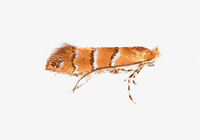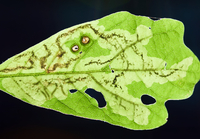Identification
Adult Markings: The following is based on the description by Clemens (1859) and Braun (1908). The palps are whitish. The face is white and tinged with reddish orange that deepens towards the vertex. The head tuft, thorax, and ground color of the forewing are all reddish orange, and the antenna is dark gray above. The forewing has silvery markings that are dark margined externally. At about one-third the wing length there is a silvery fascia that is very indistinctly angulated near the costa, and nearer the base on the dorsal margin. Just beyond the middle of the wing length there is a straight perpendicular fascia, and at about three-fourths a pair of opposite silvery streaks. These are often united in the middle of the wing to form a third fascia. The apex has a velvety blackish brown patch, with a few silvery scales immediately before the patch. The cilia are mostly reddish brown, but transition to gray at the tornus. A dark brown line extends through the middle of the cilia. The hindwing and cilia are blackish brown, while the abdomen is blackish brown in the female and gray in the male. The legs are pale brownish gray, with the tarsi whitish, and shaded with gray toward their bases. Braun (1908) noted that C. obstrictella can be distinguished from all other allied eastern species by the black scales which form the apical dusting and do not reach the tornus as in C. guttifinitella . These scales are more freely tipped with black than is usual and form a large black spot or patch rather than a number of small dots as seen in some species.
Wingspan: Expanse 7-8 mm (Braun, 1908)
Adult ID Requirements: Identifiable from good quality photos of unworn specimens.
Immatures and Development: The larvae produce upperside mines on oaks. According to Braun (1908), the mine is typically a rather broad Y-shaped track that sometimes crossing the midrib. In some cases the mines do not fork. Mines that we have observed in North Carolina are often communal and may reflect the fusion of individual mines with time. Two White Oak leaves that were observed in Buncombe Co. had communal mines with two larvae per leaf. The mines tended to be placed along lateral veins, were often broadly lobed, and the fecal pellets were located centrally near the veins. One communal mine from Madison Co. on a seedling White Oak contained seven larvae and was similar to the Buncombe Co. specimens in having several lobes and frass deposited away from the edges of the mine. Local populations appear to have at least two broods per year, and pupation occurs within the mine. Adults from Madison Co. that were reared from mines collected in the summer did not produce a nidus, while larvae collected in the fall from Buncombe Co. did. Specimens that were observed by Braun (1908) produced a flat, oval, silken-cocoon (nidus) that was spun near the fork of the mine. The fall brood overwinters in the leaves, and the adults emerged the following spring.
Larvae ID Requirements: Identifiable only through rearing to adulthood.

 »
»




 »
»


